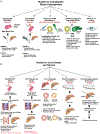Recent developments in etiology and disease modeling of biliary atresia: a narrative review
- PMID: 33615212
- PMCID: PMC7891552
- DOI: 10.21037/dmr-20-97
Recent developments in etiology and disease modeling of biliary atresia: a narrative review
Abstract
Biliary atresia (BA) is a rare but severe fibroinflammatory disease of the extrahepatic and the intrahepatic bile ducts. Without prompt interventions, BA has fatal outcomes and is the most common indicator for pediatric liver transplantation (LTx). While the mainstay of treatment involves surgically correcting the extrahepatic biliary obstruction via Kasai hepato-portoenterostomy (KHPE), activation of a multitude of biological pathways and yet-to-be-determined etiology in BA continue to foster liver inflammation, cirrhosis and need for LTx. However, important caveats still exist in our understandings of the biliary pathophysiology, the rapidity of liver fibrosis and progression to liver failure, largely due to limited knowledge of the triggers of biliary injury and the inability to accurately model human BA. Although inconclusive, a large body of existing literature points to a potential viral infection in the early peri- or postnatal period as triggers of epithelial injury that perpetuates the downstream biliary disease. Further confounding this issue, are the lack of in-vivo and in-vitro models to efficiently recapitulate the cardinal features of BA, primarily liver fibrosis. To overcome these barriers in BA research, new directions in recent years have enabled (I) identification of additional triggers of biliary injury linked mostly to environmental toxins, (II) development of models to investigate liver fibrogenesis, and (III) translational research using patient-derived organoids. Here, we discuss recent advances that undoubtedly will stimulate future efforts investigating these new and exciting avenues towards mechanistic and drug discovery efforts and disease-preventive measures. The implications of these emerging scientific investigations and disease modeling in severe fibrosing cholangiopathies like BA are enormous and contribute substantially in our understandings of this rare but deadly disease. These findings are also expected to facilitate expeditious identification of translationally targetable pathways and bring us one step closer in treating an infant with BA, a population highly vulnerable to life-long liver related complications.
Keywords: Biliary atresia (BA); fibrosis; mouse models; neonatal cholestasis; triggers of biliary atresia.
Conflict of interest statement
Conflicts of Interest: All authors have completed the ICMJE uniform disclosure form (available at http://dx.doi.org/10.21037/dmr-20-97).The authors declare no commercial or financial relationships that could be extended as a potential conflict of interest.
Figures


Similar articles
-
Rotavirus Infection and Cytopathogenesis in Human Biliary Organoids Potentially Recapitulate Biliary Atresia Development.mBio. 2020 Aug 25;11(4):e01968-20. doi: 10.1128/mBio.01968-20. mBio. 2020. PMID: 32843549 Free PMC article.
-
A novel model of injured liver ductal organoids to investigate cholangiocyte apoptosis with relevance to biliary atresia.Pediatr Surg Int. 2020 Dec;36(12):1471-1479. doi: 10.1007/s00383-020-04765-2. Epub 2020 Oct 21. Pediatr Surg Int. 2020. PMID: 33084932
-
Development of liver inflammatory injury in biliary atresia: from basic to clinical research.Pediatr Surg Int. 2023 May 30;39(1):207. doi: 10.1007/s00383-023-05489-9. Pediatr Surg Int. 2023. PMID: 37249714 Review.
-
Transcription factor GATA6: a novel marker and putative inducer of ductal metaplasia in biliary atresia.Am J Physiol Gastrointest Liver Physiol. 2018 May 1;314(5):G547-G558. doi: 10.1152/ajpgi.00362.2017. Epub 2018 Feb 1. Am J Physiol Gastrointest Liver Physiol. 2018. PMID: 29388792 Free PMC article.
-
Recent advances in understanding biliary atresia.F1000Res. 2019 Feb 25;8:F1000 Faculty Rev-218. doi: 10.12688/f1000research.16732.1. eCollection 2019. F1000Res. 2019. PMID: 30828434 Free PMC article. Review.
Cited by
-
Vitamin D3/VDR alleviates double-stranded RNA virus -induced biliary epithelial cell damage by inhibiting autophagy.BMC Gastroenterol. 2025 Jan 29;25(1):44. doi: 10.1186/s12876-025-03640-5. BMC Gastroenterol. 2025. PMID: 39881269 Free PMC article.
-
Association analysis and functional follow-up identified common variants of JAG1 accounting for risk to biliary atresia.Front Genet. 2023 May 15;14:1186882. doi: 10.3389/fgene.2023.1186882. eCollection 2023. Front Genet. 2023. PMID: 37255715 Free PMC article.
-
Research on biliary atresia and epigenetic factors from the perspective of transcriptomics: identification of key genes and experimental validation.Front Pediatr. 2025 Jul 17;13:1624671. doi: 10.3389/fped.2025.1624671. eCollection 2025. Front Pediatr. 2025. PMID: 40746357 Free PMC article.
-
Biliary atresia-specific deciduous pulp stem cells feature biliary deficiency.Stem Cell Res Ther. 2021 Nov 22;12(1):582. doi: 10.1186/s13287-021-02652-8. Stem Cell Res Ther. 2021. PMID: 34809720 Free PMC article.
-
Inhibition of Notch3/Hey1 ameliorates peribiliary hypoxia by preventing hypertrophic hepatic arteriopathy in biliary atresia progression.Histochem Cell Biol. 2024 Jun;161(6):461-476. doi: 10.1007/s00418-024-02278-w. Epub 2024 Apr 10. Histochem Cell Biol. 2024. PMID: 38597939
References
-
- Verkade HJ, Bezerra JA, Davenport M, et al. Biliary atresia and other cholestatic childhood diseases: Advances and future challenges. J Hepatol 2016;65:631–42. - PubMed
Grants and funding
LinkOut - more resources
Full Text Sources
